“Jubbah is one of the most curious places in the world, and to my mind one of the most beautiful,” wrote Lady Anne Blunt. The granddaughter of Lord Byron had arrived in January 1879 with her husband, Wilfrid, at the oasis twothirds of the way across the Nafud desert. En route to the city of Hail to see, and perhaps buy, some of the famous horses of Ibn Rashid, then ruler in Najd, they were among the first travelers from the West to set foot in Jubbah.
Although not geologists, they recognized that the plain, more than 16 kilometers long and five kilometers wide (10 x 3 mi)—“a great bare space fringed by an ocean of sand” and overlooked by a sandstone massif”—was the site of a former lake. Among the rocks, Wilfrid found inscriptions. They had been on the lookout for traces of ancient writing, but had “hitherto found nothing except some doubtful scratches, and a few of those simple designs one finds everywhere on the sandstone, representing camels and gazelles.”
 |
Near Bir Hima, in Saudi Arabia’s southern Najran region, a parade of piebald long-horned cattle, ibex, ostrich and camel-riders marches above the surrounding plains. The frieze shows a variety of styles, suggesting it was carved by several artisans at widely differing times. |
 hen it came to rock art, 19th-century westerners were interested mainly in writing: Anything else they found unworthy of attention. But attitudes have changed. Today, rock art is recognized as sophisticated, complex and esthetically interesting evidence of how early humans socialized their landscapes. Pictures carved or pecked into rock speak to us all, however faintly or incomprehensibly, across great divides of time, and appeal powerfully to our imaginations. According to Paul Bahn, a leading scholar of prehistoric art, it “gives humankind its true dimension” by showing that even from the earliest times, “human activities hold meanings other than those of a purely utilitarian kind.”
hen it came to rock art, 19th-century westerners were interested mainly in writing: Anything else they found unworthy of attention. But attitudes have changed. Today, rock art is recognized as sophisticated, complex and esthetically interesting evidence of how early humans socialized their landscapes. Pictures carved or pecked into rock speak to us all, however faintly or incomprehensibly, across great divides of time, and appeal powerfully to our imaginations. According to Paul Bahn, a leading scholar of prehistoric art, it “gives humankind its true dimension” by showing that even from the earliest times, “human activities hold meanings other than those of a purely utilitarian kind.”

 |
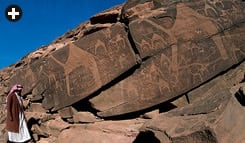 |
TOP: The so-called “Lion of Shuwaymas,”the site’s largest petroglyph, testifies to a past climate very differentfrom Saudi Arabia’s present one.
BOTTOM: Mamduah Ibrahim al-Rasheedi stands before a few of the scores of petroglyphs at Shuwaymas whose discovery he reported to national antiquities authorities. |
The “simple designs” that the Blunts saw can still be seen today: a veritable gallery of rock art that survives in the stark mountain area west of what is now a small modern town. The parade of images and elaborate symbols, left there by successive prehistoric nomadic and settled groups, leads up to more recent written inscriptions that lie on the horizon of history.
Nearly a century after the Blunts’ visit, scholars began to grasp the importance of these pictures. The first statesponsored archeological and paleo-environmental surveys of Jubbah and other sites were conducted by Saudi Arabia’s Department of Antiquities in 1976 and 1977. These located and recorded thousands of images and inscriptions, and they proved that the Jubbah site did indeed lie on an ancient lakebed stretching eastward from the sandstone mountain called Jabal Um Sanaman, “Two Camel-Hump Mountain.”
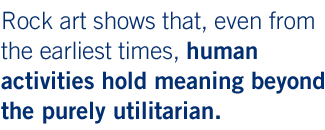
And now, some 30 years after the surveys, Jubbah is the centerpiece of some 2000 known rock-art sites across Saudi Arabia. Both within the country and internationally, with interest sparked by new finds and increasingly accurate dating methods, their significance is finally emerging.
Although rock art has been found in just about every nation, Saudi Arabia’s extensive heritage has remained virtually unknown. For example, the 1998 Cambridge Illustrated History of Prehistoric Art does not mention Saudi Arabia, and its map of prehistoric rock-art sites shows the whole of the Arabian Peninsula as a blank.
This shows how much there is yet to learn, says Robert Bednarik, founder and current president of the International Federation of Rock Art Organizations (IFRAO). “Saudi Arabia is one of the four richest regions in the world for rock art, along with South Africa, Australia and India. It possesses a major concentration of sites—yet, until now, this has not been realized internationally.”
Bednarik paid his first visit to Saudi Arabia in November, including a visit to a major new discovery in a remote area of Saudi Arabia that until now was thought to be devoid of rock art. The site, called Shuwaymas after the nearest village, “stands ready to surpass...any other rock-art site on the Arabian Peninsula,” he says.
In contrast to Jubbah, Shuwaymas is surrounded by black volcanic lava, not sand, in one of the dry valley systems in the south of Hail province. Professor Saad Abdul Aziz al-Rashid, Deputy Minister for Antiquities and Museums, calls it “a unique and very important find,” and points out that it can tell us much about the early domestication of animals. “As well as rock art, there are also numerous ancient stone ‘kites,’ mounds, tails and enclosures in the area,” says al-Rashid.
The discovery came in March 2001, when a Bedouin told Mahboub Habbas al-Rasheedi, a teacher in the nearby town, about rock images he had spotted while grazing his camels. After days scouring the crumbling sides of valleys up to 65 kilometers (40 mi) distant from the school, al-Rasheedi stumbled into a proliferation of rock art tableaux, including an unusually detailed carving nearly two meters (6') from head to tail that has been dubbed “the lion of Shuwaymas.”
 |
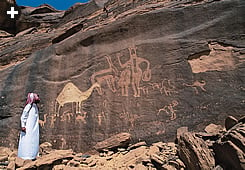 |
TOP: An ostrich is the prey for a lance-wielding, horse-borne rider.
BOTTOM: Above the plain near Bir Hima, the camel on this panel is a recent addition to an otherwise curious frieze: An oryx faces one of the most naturalistic human figures found in Saudi rock art; he wields a spear and holds what may be a shield, wears feathered headgear and shows what may be tattoos on his abdomen. A smaller figure— a child?—appears under his arm. |
Further explorations by al-Rasheedi and his brother Saad yielded fresh discoveries incised and pecked into the rock: images of cheetah, hyenas, dogs, long- and short-horned cattle, oryx, ibex, horses, mules, camels and ostrich; human figures; geometric shapes, serpentine squiggles, inscrutable symbols, carved-out footprints and, perhaps, hoofprints.
“We kept coming back to reflect on the place, on what these pictures mean and the stories they tell. Somehow we are connected to them,” says Mahboub al-Rasheedi. The brothers took their local school superintendent, Mamduah Ibrahim al-Rasheedi, to the site. “As soon as I returned home,” says Mamduah, “I clambered up a nearby hill where my cell phone can work, and I called the provincial director of antiquities in Hail to report that we had found something.”
“The Shuwaymas area is densely peppered with rock art, and it likely had a very heavy and significant concentration of Neolithic people,” says Bednarik, whose more than 650 publications in more than 50 professional journals make him one of the most extensively published archeological authors. “Clearly a great deal of labor has been invested here. It reminds me of Egyptian material and also Saharan rock art. There are lots of questions here that, if answered, could well change opinions and attitudes. This is the beginning of a major research opportunity.”
Jubbah, 30 years ago, was just as little known as Shuwaymas is now. But now we are aware that Arabia has not always been desert, and indeed that the region has undergone considerable climatic changes. The sequence of strata in the lakebed at Jubbah is similar to those in locations in the Rub’ al-Khali (the Empty Quarter) and the al-Jafr Basin in Jordan, as well as long-dry African lake basins in the Sahara. All of this region underwent successive moist and arid periods, and during the Neolithic Wet Phase (9000–6000 years ago), savanna grasslands supported cattle.
Archeologists have found evidence of four major periods of settlement at Jubbah stretching back through the Middle Paleolithic period, 80,000 to 25,000 years ago. They also found Neolithic sites and evidence of early trade: finely retouched arrowheads, blades and awls manufactured from stone that had been carried in from sources up to 145 kilometers (90 mi) away.
The panoply of rock art around Jubbah’s Jabal Um Sanaman covers some 39 square kilometers (15 sq mi), and it presents a rich, often perplexing gallery, including panels depicting early domesticated dogs and longhorned cattle, and others that suggest a transition from hunter-gatherer to agricultural communities. The abundant images of camels raise the intriguing possibility that the camel was first domesticated in northern Arabia, not southern, as is usually believed. Among the hundreds of thousands of camel figures carved in rocks throughout the Arabian Peninsula, the ones at Jubbah are believed to be the oldest: At approximately 4000 years old, they date back to the beginning of the Bronze Age.
Among the most recent markings in the chronology of Jubbah’s early civilizations are 3000-year-old inscriptions in Thamudic, the oldest known script of the Arabian Peninsula. Majeed Khan, the leading authority on the rock art of Arabia and the Middle East, is currently an advisor to the national Antiquities Department; he has spent 30 years studying rock art and inscriptions. The Thamudic script, he says, “evolved independently within the Peninsula from an earlier rock-art system of communication, an embryonic form of writing employing elaborate signs and symbols as ideograms.”
Along with Khan, archeologist Juris Zarins worked on the early surveys in the mid-1970’s, before joining the faculty of Southwest Missouri State University. Over the past two decades, he has taken many SMSU students to Saudi Arabia, and he was chief archeologist of the 1992 Transarabia Expedition, which made the headline-grabbing discovery of what they believed was the ancient city of Ubar.
“Pound for pound and piece for piece, in terms of rock art concentration and importance, Jubbah is the number-one or number-two site in the whole of the Middle East,” Zarins says. “It rivals anything in North Africa. With the art going back at least to the Pottery Neolithic period 7000 to 9000 years ago, and with paleo-environment and geology showing traces of human activity extending into the Middle Paleolithic period, it’s a treasure trove for answering questions about the Middle East.”
If so, then why has Saudi Arabia so long remained a blank spot on the international rock-art map? One reason, contends Zarins, has to do with an ancient bias: “Throughout the world, scholarship has always slighted deserts. Even the ancients despised the desert people. This has carried over into the modern world, since history is written by settled, civilized peoples.”
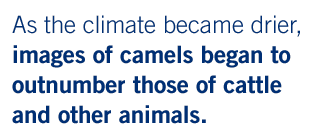 What makes the oversight more curious still is that there has been activity between the time of the Blunts’ visit and the modern Saudi studies. In 1972, a four-volume work, Rock-Art in Central Arabia, was published by Emmanuel Anati. Although he never visited the country, he worked from a huge corpus of photographs, tracings and sketches acquired from the explorer, mapmaker and writer on Arabia Harry St. John Philby. In the winter of 1952, Philby had set off on a three-month field survey of rock art and inscriptions in the south of the country. Accompanying him were a renowned Belgian scholar of Semitic studies, Monseigneur Gonzague Ryckmans, pre-Islamic historian Jacques Ryckmans and a photographer of rock art and epigraphy, Count Philippe Lippens. The expedition returned to Riyadh with records of 13,000 previously unknown petroglyphs. “Sad to say,” wrote Elizabeth Monroe, Philby’s biographer, in 1973, “only a fraction of this major addition to the world’s knowledge of Arabia has so far been published.” (The originals are today at St. Antony’s College, Oxford.) So rich was one of the sites west of the ancient wells of Bir Hima that one of the expedition members was able to copy 250 images without moving from his seat.
What makes the oversight more curious still is that there has been activity between the time of the Blunts’ visit and the modern Saudi studies. In 1972, a four-volume work, Rock-Art in Central Arabia, was published by Emmanuel Anati. Although he never visited the country, he worked from a huge corpus of photographs, tracings and sketches acquired from the explorer, mapmaker and writer on Arabia Harry St. John Philby. In the winter of 1952, Philby had set off on a three-month field survey of rock art and inscriptions in the south of the country. Accompanying him were a renowned Belgian scholar of Semitic studies, Monseigneur Gonzague Ryckmans, pre-Islamic historian Jacques Ryckmans and a photographer of rock art and epigraphy, Count Philippe Lippens. The expedition returned to Riyadh with records of 13,000 previously unknown petroglyphs. “Sad to say,” wrote Elizabeth Monroe, Philby’s biographer, in 1973, “only a fraction of this major addition to the world’s knowledge of Arabia has so far been published.” (The originals are today at St. Antony’s College, Oxford.) So rich was one of the sites west of the ancient wells of Bir Hima that one of the expedition members was able to copy 250 images without moving from his seat.
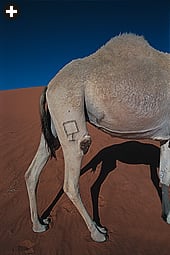 |
Marks, known as wasum, like this one branded onto a camel’s leg, are tribal symbols of ownership. Scholars are finding more and more links between rock-art designs and the nearly 4000 known wasum.
|
‘‘Look carefully at the black rock,” says Naif al-Ateek, the curator of the rock-art site at Jubbah and a descendant of the town amir who welcomed the Blunts. “If you concentrate, you’ll see a faint carving lying behind the clear and lighter top one.” Even with such a lead— for without it only the superficial images would register—intently staring at the blackened rock surface is an exercise akin to picking out a modern threedimensional picture that appears buried within an inscrutable, computer-generated pattern. Yet al-Ateek is right: If one adjusts one’s eye, focusing and refocusing slowly, another image appears in the background, a work executed perhaps millennia before the more apparent images.
“The darker ones are the oldest,” he explains, showing a life-sized figure, depicted with a characteristic oval head, holding a curved, boomerang-like throwing stick and followed by a short-horned bovine. “Now let me show you our prize figure, an ancient ruler.” Finely incised in the dark patina of desert varnish is a life-sized male human figure with a crownlike headdress. Nearby is the curved horn of an ibex reaching and arching to its back, its face complete with a small beard.
Later, after a day spent scrambling over rock surfaces, al-Ateek serves coffee in the same smoke-blackened parlor that the Blunts sat in. He has built up a small museum that includes several rock-art fragments found in the sands and brought in by Bedouin over the years.
“We are proud of our mountain and the heritage it contains,” says Bandar al-Amar, who has opened Jubbah’s own Internet café, runs computer courses and created an Arabic-language website for the town (jubbah.netfirms.com). “Twenty years ago our parents pressed to have a tarred road brought across the dunes to Jubbah from Hail,” he says. “The authorities suggested that we move to Hail and resettle in the modern town. The answer was ‘Okay, so long as you move our mountain with us.’ This here is all part of our deep past, even though its history is difficult to understand.”
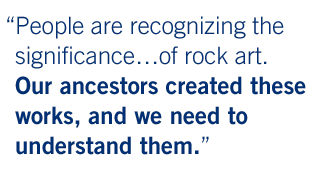 Just six years ago, a rock with one of Arabia’s most intriguing petroglyphs was moved: A helicopter hoisted it from its site 160 kilometers (100 mi) north of Najran and lowered it onto a flatbed trailer, and it was later craned onto the marble floor of Riyadh’s National Museum. The rough, pyramid-shaped sandstone rock, 1.3 meters (4') tall, shows arms and hands waving on one side and another hand, apparently with a broken arm, on the other. The motif is ubiquitous in rock art throughout the world.
Just six years ago, a rock with one of Arabia’s most intriguing petroglyphs was moved: A helicopter hoisted it from its site 160 kilometers (100 mi) north of Najran and lowered it onto a flatbed trailer, and it was later craned onto the marble floor of Riyadh’s National Museum. The rough, pyramid-shaped sandstone rock, 1.3 meters (4') tall, shows arms and hands waving on one side and another hand, apparently with a broken arm, on the other. The motif is ubiquitous in rock art throughout the world.
The Department of Antiquities and Museums is also quartered at the National Museum. In his office, surrounded by journals, surveys, publications and rock-art conference proceedings, Majeed Khan explains why he prefers not to interpret the meaning of the waving hands, let alone any other rock art images.
“The biggest challenge with rock art is chronology and dating. Once we tried to interpret the art, but with our modern minds interpretation is entirely hypothetical. So now we concentrate on dating, chronology and the technical aspects.” He adds one exception, unique to Saudi Arabia: Tribal markings called wasum are still used today by Bedouin to mark territorial and animal possessions. They provide a modern link with much older rock art. Khan’s Wasum: The Tribal Symbols of Saudi Arabia was published by the Ministry of Education in 2000.
In the museum gallery, Khan demonstrates further the pitfalls of interpretation. “You might say this is a territorial marker,” he says as he and a group of schoolchildren ponder the rock with the waving hands. “That child might say it’s a keep-out sign, for the broken arm on the rear face shows the consequence of intrusion. I might suggest that it reveals supplication to some deity. You could speculate these incised images from handprints daubed onto the rock are mere doodles by a person with time—and paint—on his hands: Art for art’s sake!
“With such a diversity of ideas, how can we interpret the meaning of people’s thoughts thousands of years ago?” asks Khan. “One thing is clear to me though: These images were symbolic, communicating meaning which the artist and the ancient people of the time could understand.”
Khan’s words echo those of Paul Bahn. In most rock art, argues Bahn, “individual artistic inspiration was related to some more widespread system of thought and had messages to convey: signatures, ownership, warnings, exhortations, demarcations, commemorations, narratives, myths and metaphors.”
Among the younger Saudi scholars devoted to rock art is Abdulraheem Hobrom, one of the first to undertake postgraduate studies in the subject at Riyadh’s King Sa‘ud University. He sees a wide-open field, and attitudes changing in ways that will favor further study. “Islam encourages us to explore and discover the world. People are recognizing the significance of the shared legacy and heritage of rock art. Our ancestors created these works, and we need to understand them,” he says.
More publications, increased survey activities and a documentary film in progress, intended for broadcast in Europe, all show the growing interest in Saudi rock art, says Daifallah al-Talhi, director general of the Antiquities Research and Survey Center. “We display rock art in our provincial museums, our mobile exhibition on education in history includes it and we will soon launch a website for the National Museum which will feature petroglyphs,” he says. Provincial representatives of the Ministry of Education discuss the country’s rock-art heritage in presentations to schools throughout Saudi Arabia’s 13 provinces.
This heightened interest, naturally, is leading to another prospect—more discoveries. Saad al-Rashid is a busy man these days, one who often returns to his office at the National Museum in the evenings to work past midnight. He talks of prospects for new studies to address the questions that multiply with the discoveries. “To what extent are the wasum of today inherited by tribes, and were there tribes that no longer exist? When were the animals domesticated in Arabia? There are so many facets to examine— and of course always the scientific challenge of accurate absolute dating.”
 |
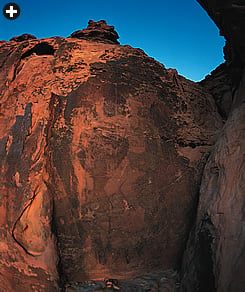 |
TOP: Locally called “The King,” this large, heavily eroded human figure, seen in profile, has muscular arms, fingers on each hand, a blank face, a short skirt and a headdress that may be made of ostrich feathers. Experts believe it probably dates from the Neolithic period, making it between 6000 and 9000 years old.
BOTTOM: One of the most unusual petroglyphs at Jubbah is this horse-drawn chariot, shown in an unusual vertical perspective. It is probably 2000 to 2500 years old. Jubbah’s greatest value is that it contains petroglyphs from most major phases of habitation: Middle Paleolithic, Neolithic, Chalcolithic, Bronze Age, Iron Age, Thamudic and Arabic. |
His enthusiasm is echoed by Bednarik. “Saudi Arabia is taking on a pioneer role. This could lead to better things in terms of rock-art studies in other Arab countries, and opting for a scientific approach rather than one of interpretation makes eminent sense. It’s also appropriate, as the Arabs were at the forefront of scientific tradition and innovation in the past.”
In the middle of the broad, flat, sandy valley of the Shuwaymas site, a small campfire flickers under a canopy of stars in a crystalline sky. Sharing its warmth, sipping coffee and tea, are two Bedouin who live in tents a few kilometers away and who are now officially charged with guarding the site. Also sitting at the fire are Mamduah Ibrahim al-Rasheedi, the school superintendant who called in the find, his teacher colleagues and Saad Rowaisan, the visiting provincial director of antiquities from Hail. They muse over how this once-populated site has been virtually unknown for nearly the full duration of recorded history, and they speculate what their find will bring to this remote area: survey teams, archeologists, students, international specialists, film crews and curious visitors with four-wheel drives and GPS navigation units. Al-Rasheedi already plans a visit for his schoolchildren. There will, of course, be more.
As the coffee-maker tends the embers, talk turns to the people who left their mark on the rocks. “Our children will ask, ‘Who were the people who left all this? How did they live, how did they cut the pictures and symbols in the stone?’” says Ruwaisan. “‘What were the dogs used for, and why did the cows, lions and cheetahs disappear?’”
Later, after a simple meal, the conversation dies, marking the time for reflective silence interspersed with poetry recitations. The small cloaked gathering draws closer to the fire and listens to verses from an eighth-century qasidah by Jarir ibn ‘Atiya that opens in the traditional way, with an image of a deserted campsite. Like the art flickering faintly on the rocks, it seems to speak from a distant past.
O, how strange are the deserted campsites and their long-gone inhabitants!
And how strangely time changes all!
The camel of youth walks slowly now;
Its once quick pace is gone; it is bored with traveling.
 |
Peter Harrigan (harrigan@zajil.net) works with Saudi Arabian Airlines in Jiddah, where he is also a contributing editor and columnist for Diwaniya, the weekly cultural supplement of the Saudi Gazette. He has enjoyed close encounters with rock art in numerous journeys in the Arabian Peninsula over the past two decades. |
 |
Lars Bjurström (larsbjurstrom@hotmail.com) has lived for four years in Riyadh, where he practices dentistry and pursues his love of wildlife and exploration photography. “The difficulty with photographing petroglyphs is to make them stand out,” he says. “To get the right light meant I had to get to the right petroglyph at the right time of day, and that meant getting up with the sun and chasing it around the sites. Getting to their locations just to photograph them is hard enough, so the fact of their creation is all the more astounding.” |
Related articles can be found on our magazine’s web site, www.saudiaramcoworld.com. Click on “indexes,” then on the cover of the issue indicated below.
Lady Anne Blunt: M/J 80
Archeological survey: M/A 80
Stone “kites”: M/J 00
Lakes of the Rub’ al-Khali: M/J 89
National Museum: S/O 99
Tourism in Saudi Arabia: M/A 01
This article appeared on pages 18-25 of the Compilation Issue 2008 print edition of Saudi Aramco World.
Check the Public Affairs Digital Image Archive for Compilation Issue 2008 images.